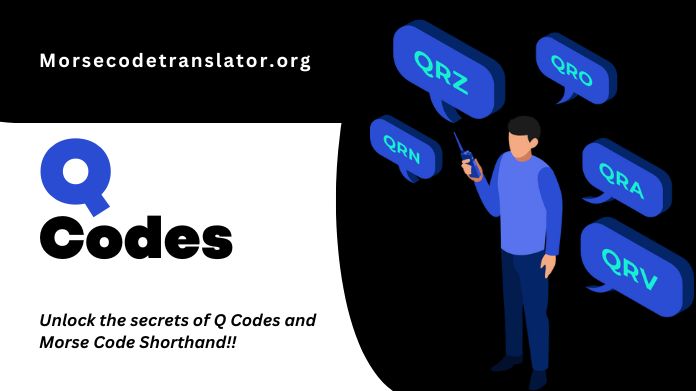In the world of telecommunication, efficiency, and clarity have always been paramount. Morse Code, with its concise dots and dashes, revolutionized long-distance communication.
Building upon this legacy, the Q Codes and Morse Code Shorthand have emerged as powerful tools for streamlined communication in radio and telegraphy.
This complete guide delves into the intricate world of Q Codes and Morse Code Shorthand, unraveling their history, structure, and practical applications.
Join us on a journey through the coded language that has played a pivotal role in enhancing communication efficiency across the airwaves as we explore the nuances and significance of these codes in telecommunication.
What Are Q Codes?

Q codes are three internationally defined letters that all begin with the letter Q. They are used to swiftly and precisely communicate typical queries and their responses. They can be three-letter acronyms.
The Navy adopted the first Q codes as a shorthand communication system in 1909 after the British government created them. Since they made it possible for operators who spoke multiple languages to communicate quickly and clearly, they were embraced globally.
Although Q codes were first developed as Morse codes, they are also used in spoken communication and with contemporary technology.
How to Use Q Codes?
Using Q Codes involves employing three-letter codes, initially developed for radiotelegraph communication, to convey information concisely and efficiently. While these codes are deeply rooted in amateur radio, they have found applications in various aspects of communication.
Here’s a guide on how to use these Codes:
1. Understand the Basics: They are structured with a leading “Q” followed by a two-letter code (e.g., QTH, QSL, QRM). Each code has a specific meaning or query associated with it.
2. Learn Common Q Codes: Familiarize yourself with commonly used Q Codes, such as:
- QTH: What is your location?
- QSL: I acknowledge receipt.
- QRM: Interference from artificial sources.
- QRP: Reduce power.
- QRT: Stop sending.
- QSY: Change frequency.
3. Adapt to Context: Use Q Codes in the appropriate context. For example, QTH is often used to inquire about someone’s location, while QSL is used to confirm the receipt of a message.
4. Combine with Morse Code: It can be transmitted using Morse Code, adding efficiency to communication. Each letter in the Q Code corresponds to Morse Code elements, making it suitable for telegraphy.
5. Use in Radio Communication: These codes are prevalent in amateur radio and maritime communication. Operators use these codes to convey information quickly and clearly, especially when brevity is essential.
6. Practice Proper Etiquette: When using Q Codes in communication, adhere to proper radio etiquette. Wait for an suitable break in the conversation before transmitting, and avoid unnecessary repetition.
7. Acknowledge and Confirm: Q Codes like QSL are often used to acknowledge the receipt of a message or signal. Respond appropriately to confirm or provide additional information.
8. Stay Informed: Q Codes are dynamic, and new ones may emerge over time. Stay informed about any updates or changes to ensure accurate and effective communication.
9. Be Clear and Concise: The primary purpose of codes is to convey information quickly and clearly. Be concise in your usage, ensuring the intended message is easily understood.
10. Tailor to Your Needs: While there are standard codes, individuals or organizations may develop variations to suit specific communication needs. Ensure mutual understanding when using customized codes.
Final Note
In communication, Q Codes and Morse Code Shorthand are like secret languages that make messages short and sweet. This guide has shown us how these codes, with their three-letter combos, dots, and dashes, help people talk quickly and clearly, especially in radio chats.
Q Codes, with their “Q” followed by two letters, are shortcuts for different messages. They help people ask questions, confirm things, or tell others what to do, all in a snappy way. And when you add Morse Code to the mix, it’s like sending messages in a super-fast secret code.
So, as we wrap up, Q Codes and Morse Code Shorthand are handy tools for quick and efficient communication. Whether you’re a radio enthusiast or just curious about how people talk, these codes keep messages flowing smoothly across the airwaves.
